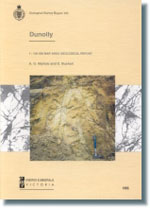GSV Report 105 - Dunolly 1:100 000 map area geological report
 |
| |||||||||||||||||||||||||||||||||||||||||||||||||||||||||
Product description:Download The downloadable version of this report is supplied in PDF format and is a large file (10.7MB). Abstract The Dunolly 1:100 000 map area lies astride the boundary between the Bendigo-Ballarat and Stawell zones of the Lachlan Fold Belt of Victoria. The Avoca Fault, which is the boundary between these zones, separates the two main marine turbidite sequences: the Cambro-Ordovician Saint Arnaud Group in the west, and the Lower Ordovician Castlemaine Supergroup in the east. Flexural slip folding, resulting from east-west compression, produced regional meridional F1 folds characterized by sub-horizontal fold hinges. The folding was accompanied by lower greenschist facies metamorphism and the development of a strong axial planar cleavage. Associated recrystallisation led to the development of a strong meridional S1 schistosity. Fold amplification then progressed from flexural slip folding associated with bedding parallel slip, to shear folding associated with shear on schistosity surfaces. A number of distinct styles of D2 deformation are recognised along the length of the Avoca Fault zone. The deformation decreases in intensity from a zone of distinct faulting in the south, through a zone of fault-propagation folding, to a zone of crenulation folding in the north. South of the Mount Hooghly pluton the fault zone is characterized by a higher intensity of deformation, in a zone of a few hundred metres wide. The D2 deformation associated with the Avoca Fault was followed by more widespread D3 deformation which produced a spaced crenulation cleavage in shear zones. The S3 fabric is slightly discordant with the S1 schistosity, indicating a slight anti-clockwise rotation of the principal compression direction. Intrusion of the Devonian granites has resulted in D4 deformation in the contact aureoles producing weak S4 fabrics which have formed in direct response to the emplacement of the granites by a ballooning mechanism. Deformation D5 post-dates the Devonian granites and produced locally developed chevron folds and a crenulation cleavage. The Devonian granites have developed by fractional crystallisation and some plutons show evidence of a number of cycles of magmatism. They normally have well developed contact aureoles. Gold mineralization is structurally controlled by relatively minor scale faults which have developed within regional meridional shear zones during an extended period of D1 to D3 deformation. The mineralization is contemporaneous with the introduction of quartz veins within the controlling structures. Gold generally occurs as free gold in early-formed massive quartz, or as gold-sulphide assemblages in late-formed laminated quartz in fault zones. Gold and sulphide are especially well developed in laminations and stylolites in laminated quartz. Sulphides include pyrite, arsenopyrite, chalcopyrite, sphalerite, galena and rare pyrrhotite. Textural relationships indicate the gold and the chalcopyrite are relatively late in relation to sphalerite, pyrite and arsenopyrite. Previously unrecorded bedded, laminated and brecciated ironstones contain traces of gold. The continuum from quartz vein to ironstone vein reflects a variation in the composition of the fluids which were focused into the fault controlled dilatant zones. Bibliographic reference Marlow, A.G. & Bushell, D., 1995. Dunolly 1:100 000 map area geological report. Geological Survey of Victoria Report 105. Related products:
| ||||||||||||||||||||||||||||||||||||||||||||||||||||||||||





